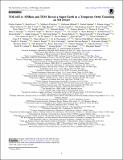TOI-1452 b: SPIRou and TESS Reveal a Super-Earth in a Temperate Orbit Transiting an M4 Dwarf
Author(s)
Seager, Sara
DownloadPublished version (6.361Mb)
Publisher with Creative Commons License
Publisher with Creative Commons License
Creative Commons Attribution
Terms of use
Metadata
Show full item recordAbstract
<jats:title>Abstract</jats:title>
<jats:p>Exploring the properties of exoplanets near or inside the radius valley provides insight on the transition from the rocky super-Earths to the larger, hydrogen-rich atmosphere mini-Neptunes. Here, we report the discovery of TOI-1452b, a transiting super-Earth (<jats:italic>R</jats:italic>
<jats:sub>p</jats:sub> = 1.67 ± 0.07 <jats:italic>R</jats:italic>
<jats:sub>⊕</jats:sub>) in an 11.1 day temperate orbit (<jats:italic>T</jats:italic>
<jats:sub>eq</jats:sub> = 326 ± 7 K) around the primary member (<jats:italic>H</jats:italic> = 10.0, <jats:italic>T</jats:italic>
<jats:sub>eff</jats:sub> = 3185 ± 50 K) of a nearby visual-binary M dwarf. The transits were first detected by the Transiting Exoplanet Survey Satellite, then successfully isolated between the two 3.″2 companions with ground-based photometry from the Observatoire du Mont-Mégantic and MuSCAT3. The planetary nature of TOI-1452b was established through high-precision velocimetry with the near-infrared SPIRou spectropolarimeter as part of the ongoing SPIRou Legacy Survey. The measured planetary mass (4.8 ± 1.3 <jats:italic>M</jats:italic>
<jats:sub>⊕</jats:sub>) and inferred bulk density (<jats:inline-formula>
<jats:tex-math>
<?CDATA ${5.6}_{-1.6}^{+1.8}$?>
</jats:tex-math>
<mml:math xmlns:mml="http://www.w3.org/1998/Math/MathML" overflow="scroll">
<mml:msubsup>
<mml:mrow>
<mml:mn>5.6</mml:mn>
</mml:mrow>
<mml:mrow>
<mml:mo>−</mml:mo>
<mml:mn>1.6</mml:mn>
</mml:mrow>
<mml:mrow>
<mml:mo>+</mml:mo>
<mml:mn>1.8</mml:mn>
</mml:mrow>
</mml:msubsup>
</mml:math>
<jats:inline-graphic xmlns:xlink="http://www.w3.org/1999/xlink" xlink:href="ajac7ceaieqn1.gif" xlink:type="simple" />
</jats:inline-formula> g cm<jats:sup>−3</jats:sup>) is suggestive of a rocky core surrounded by a volatile-rich envelope. More quantitatively, the mass and radius of TOI-1452b, combined with the stellar abundance of refractory elements (Fe, Mg, and Si) measured by SPIRou, is consistent with a core-mass fraction of 18% ± 6% and a water-mass fraction of <jats:inline-formula>
<jats:tex-math>
<?CDATA ${22}_{-13}^{+21}$?>
</jats:tex-math>
<mml:math xmlns:mml="http://www.w3.org/1998/Math/MathML" overflow="scroll">
<mml:msubsup>
<mml:mrow>
<mml:mn>22</mml:mn>
</mml:mrow>
<mml:mrow>
<mml:mo>−</mml:mo>
<mml:mn>13</mml:mn>
</mml:mrow>
<mml:mrow>
<mml:mo>+</mml:mo>
<mml:mn>21</mml:mn>
</mml:mrow>
</mml:msubsup>
</mml:math>
<jats:inline-graphic xmlns:xlink="http://www.w3.org/1999/xlink" xlink:href="ajac7ceaieqn2.gif" xlink:type="simple" />
</jats:inline-formula>%. The water world candidate TOI-1452b is a prime target for future atmospheric characterization with JWST, featuring a transmission spectroscopy metric similar to other well-known temperate small planets such as LHS 1140b and K2-18 b. The system is located near Webb’s northern continuous viewing zone, implying that is can be followed at almost any moment of the year.</jats:p>
Date issued
2022Department
Massachusetts Institute of Technology. Department of Earth, Atmospheric, and Planetary SciencesJournal
Astronomical Journal
Publisher
American Astronomical Society
Citation
Seager, Sara. 2022. "TOI-1452 b: SPIRou and TESS Reveal a Super-Earth in a Temperate Orbit Transiting an M4 Dwarf." Astronomical Journal, 164 (3).
Version: Final published version